catalogue
1. Classification of IO streams:
Construction method of FileInputStream
Classification of character stream
Construction method of OutputStreamWriter
Method for OutputStreamWriter to write data
The difference between flush() and close():
Construction method of InputStreamReader
Character buffered output stream: BufferedWriter:
Character buffered input stream: BufferedReader:
7. Special data writing method of character stream:
8. Stream of operation basic data type
1, IO stream
IO stream refers to the stream used to process data transmission between devices
1. Classification of IO streams:
flow to:
The input stream reads data from the hard disk to the Java program
The output stream writes out the data and outputs the data from the Java program to the hard disk
Data type:
Byte stream
Byte input stream read data InputStream
Byte output stream write out data OutputStream
Character stream
Character input stream read data Reader
Character output stream write out data Writer
2. Byte input stream
InputStream, which is an abstract class with a subclass FileInputStream
Construction method of FileInputStream
FileInputStream(File file):
Create a FileInputStream by opening a connection to the actual file, which is named by the file object file in the file system.
FileInputStream(String string):
Create a FileInputStream by opening a connection to the actual file, which is named by the pathname name in the file system.
There are two ways to read data from byte input stream:
Member method of FileInputStream
public int read(): read one byte of data from the input stream
The maximum number of bytes read from the input B byte array of int [. Byte]:
Code example: the first method of read() reads one byte at a time
import java.io.FileInputStream;
public class Demo1 {
public static void main(String[] args) throws Exception{
// File file = new File("f.txt");
// FileInputStream fis = new FileInputStream(file);
// When encapsulating a nonexistent file, an error is reported: the system cannot find the specified file.
FileInputStream fis = new FileInputStream("d.txt");
int i=0;
// Read one byte at a time and return the ASCII code value
while((i= fis.read())!=-1){
System.out.print((char)i);//Cast type
}
fis.close();
}
}Output result: Contents in d.txt

read(byte[] b) the second method is to read one byte array at a time
import java.io.FileInputStream;
public class Demo2 {
public static void main(String[] args) throws Exception{
FileInputStream fis = new FileInputStream("a.txt");
byte[] bytes = new byte[1024];
// Define a byte array, store the bytes actually obtained in the array, and return the number of bytes actually read in the array
int length=0;
// Read one byte array at a time
while ((length= fis.read(bytes))!=-1){
System.out.println(new String(bytes, 0, length));
// Get the bytes from 0 to the number of bytes actually read in the array, otherwise the default value in the array will also be obtained
}
fis.close();
}
}Output result: for the contents in a.txt, since the length of the byte array obtained at one time is much larger than the number of bytes of the contents stored in the file, the while loop is actually executed only once, directly storing all the contents in the file into an array, and then outputting the actually obtained data in this array.
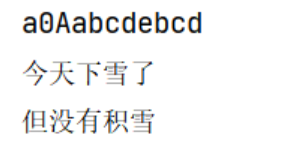
Examples:
Requirement: copy the contents of a.txt under the current project to b.txt
Code implementation:
import java.io.FileInputStream;
import java.io.FileOutputStream;
/*
Requirement: copy the contents of a.txt under the current project to b.txt
*/
public class Demo3 {
public static void main(String[] args) throws Exception {
// Create byte I / O stream object
FileInputStream fis = new FileInputStream("a.txt");
FileOutputStream fos = new FileOutputStream("b.txt");
int length=0;
byte[] bytes = new byte[1024];
while((length=fis.read(bytes))!=-1){
fos.write(bytes,0,length);
}
fos.close();
fis.close();
}
}Output result: the content in b.txt is modified to the content in a.txt
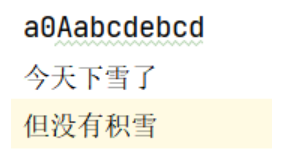
3. Byte buffer stream
The speed of byte stream reading and writing one array at a time is much faster than that of reading and writing one byte at a time. This is due to the buffer effect of array. Byte buffer stream makes the reading and writing speed more efficient
Byte buffered output stream: BufferedOutputStream
Construction method:
BufferedOutputStream(OutputStream out): creates a new buffered output stream to write data to the specified underlying output stream.
Byte buffered input stream: BufferedInputStream
Construction method:
BufferedInputStream(InputStream in): create a BufferedInputStream and save its parameters. Input the stream in for later use.
Example of byte buffered output stream:
import java.io.BufferedOutputStream;
import java.io.FileOutputStream;
public class Bdemo1 {
public static void main(String[] args) throws Exception{
BufferedOutputStream bos = new BufferedOutputStream(new FileOutputStream("d.txt"));
bos.write("big data".getBytes());
bos.close();
}
}Output result:
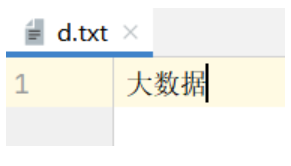
Example of byte buffered input stream:
import java.io.BufferedInputStream;
import java.io.FileInputStream;
public class Bdemo2 {
public static void main(String[] args) throws Exception{
BufferedInputStream bis = new BufferedInputStream(new FileInputStream("d.txt"));
byte[] bytes = new byte[1024];
int length = 0;
while ((length = bis.read(bytes)) != -1) {
System.out.println(new String(bytes, 0, length));
}
}
}Output result:

When the byte stream reads only one byte at a time, if the data is Chinese, symbols that we can't understand appear. This is because Chinese is composed of three bytes or two bytes. When there is only one byte, the bytes converted from Chinese characters are split for output.
A decoding and encryption method is introduced:
Encryption and decoding:
String(byte[] bytes, Charset charset)
Construct a new String and decode charset with the specified byte array. decode
byte[] getBytes(Charset charset)
Use the given charset to encode the String into a byte sequence and store the result in a new byte array. Code
Coding: change what you can understand into what you can't understand, which is similar to encryption
String -- byte[]
Decoding: change what you can't understand into what you can understand, which is similar to decryption
byte[] -- String
public class StringDemo {
public static void main(String[] args) throws Exception {
String s = "Hello";
//String -- byte[]
// byte[] bytes1 = s.getBytes("GBK");
System.out.println(bytes1);
// printArray(bytes1);
byte[] bytes2 = s.getBytes("Unicode");
printArray(bytes2);
System.out.println();
//byte[] -- String
String s1 = new String(bytes2, "Unicode");
System.out.println(s1);
}
public static void printArray(byte[] bytes){
for (byte b : bytes){
System.out.print(b+",");
}
}
}Output result:

4. Character stream
Classification of character stream
Character input stream: Reader
Character output stream: Writer
Convert byte stream to character stream: character stream = byte stream + encoding table
Character output stream
Writer
OutputStreamWriter: character output stream, which is a conversion stream obtained by adding byte stream and encoding table. When writing data later, it can be written according to the encoding specified by itself
Construction method of OutputStreamWriter
public OutputStreamWriter(OutputStream out):
Create an OutputStreamWriter that uses the default character encoding. According to the default encoding, characters are used as a bridge to convert the data of byte stream into character stream
public OutputStreamWriter(OutputStream out,String charsetName):
According to the specified encoding, characters are used as a bridge to convert the data of byte stream into character stream
Code example:
import java.io.FileOutputStream;
import java.io.OutputStreamWriter;
public class Demo4 {
public static void main(String[] args) throws Exception{
// Create character output stream object
OutputStreamWriter osw = new OutputStreamWriter(new FileOutputStream("e.txt"), "GBK");
// If there is no file, it will be created
osw.write("Long live China");
osw.close();
}
}Output result: Contents in e.txt file

It is found that the content of the file is not the Chinese characters written in the code
Reason: the output format in the file here is UTF-8. UTF-8 takes three bytes as a Chinese character. The format used in the code is GBK. GBK takes two bytes as a Chinese character. Although the format is wrong, the actual content is written into the file. You can see the content by converting the format to GBK.
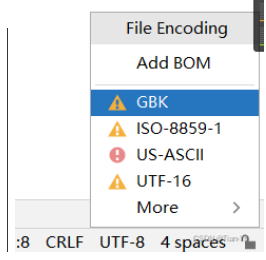
Method for OutputStreamWriter to write data
public void write(int c): write a character
public void write(char[] cbuf): write a character array
public void write(char[] cbuf,int off,int len): write a part of a character array, starting from off and having a length of len
public void write(String str): write a string
public void write(String str,int off,int len): write a part of a string, starting from off and with a length of len
Code example:
import java.io.FileOutputStream;
import java.io.OutputStreamWriter;
public class Demo5 {
public static void main(String[] args) throws Exception{
OutputStreamWriter osw = new OutputStreamWriter(new FileOutputStream("f.txt"));
// Write a character
osw.write('a');//Write a
// Write a part of a character array
char[] chars = new char[]{'a','b','c','d','e','f'};
osw.write(chars);//Write abcdef
// Write a part of a character array
osw.write(chars,3,2);//Write def
// Write a string
osw.write("CHINA");//Write CHINA
// Write part of a string
osw.write("CHINESE",4,3);//Write ESE
osw.close();
}
}Output result:

If close() is removed from the code before running, the data will not be written to the file
Reason: the file is actually stored in bytes on the hard disk, which needs to be manually converted.
Solution: use the refresh stream: void flush(), so that the data can be written successfully
The underlying flush() method is further described in the source code
The difference between flush() and close():
1. After calling flush(), the stream object is not closed and can continue to write data
2. After calling close(), the flow object is closed, and subsequent data cannot be written through this object
5. Character input stream
Reader
InputStreamReader: character input stream
Construction method of InputStreamReader
public InputStreamReader(InputStream in):
Read the data and convert the data of byte stream into character stream with characters as a bridge according to the default encoding
public InputStreamReader(InputStream in,String charsetName):
Read the data and convert the data of byte stream into character stream with characters as a bridge according to the specified encoding
Method for InputStreamReader to read data (member method)
public int read(): read one character
public int read(char[] cbuf): read characters into an array
Code example: the first way: read one character at a time
import java.io.FileInputStream;
import java.io.InputStreamReader;
public class Demo6 {
public static void main(String[] args) throws Exception{
InputStreamReader isr = new InputStreamReader(new FileInputStream("a.txt"));
int i=0;
// Read one character at a time
while((i= isr.read())!=-1){
System.out.print((char)i);
}
isr.close();
}
}The second way: read one character array at a time
import java.io.FileInputStream;
import java.io.InputStreamReader;
public class Demo6 {
public static void main(String[] args) throws Exception{
InputStreamReader isr = new InputStreamReader(new FileInputStream("a.txt"));;
System.out.println("========================");
// Read one character array at a time
int length=0;
char[] chars = new char[1024];
while((length= isr.read(chars))!=-1){
System.out.println(new String(chars,0,length));
//Use anonymous objects to convert the obtained characters to string output
}
isr.close();
}
}Output result: the content can be read in both ways
The results are the same, and the results are obtained by running respectively:
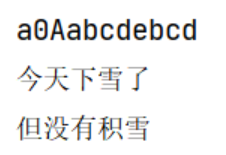
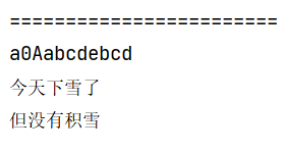
Examples:
Requirement: copy the contents of a.txt in the current project directory to c.txt in the current project directory
This is the same as the above example, but it is implemented using character input / output stream:
import java.io.FileInputStream;
import java.io.FileOutputStream;
import java.io.InputStreamReader;
import java.io.OutputStreamWriter;
/*
Copy the contents of a.txt in the current project directory to c.txt in the current project directory
*/
public class Demo7 {
public static void main(String[] args) throws Exception{
// Create character input / output stream object
InputStreamReader isr = new InputStreamReader(new FileInputStream("a.txt"));
OutputStreamWriter osw = new OutputStreamWriter(new FileOutputStream("c.txt"));
// The second method is used here: read one character array at a time
int length=0;
char[] chars = new char[1024];
while((length= isr.read(chars))!=-1){
osw.write(chars,0,length);
osw.flush();
}
// Release resources
osw.close();
isr.close();
}
}Output result:
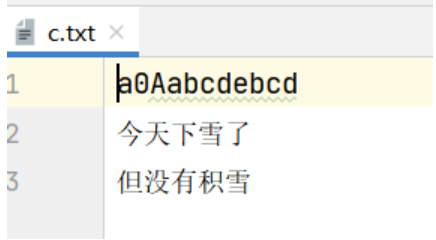
Since our common operations use the local default encoding, we basically do not specify the encoding when we use it, but when we create the character conversion stream object, the name is a little long, so Java provides subclasses for us to use
Character stream = byte stream + encoding table
OutputStreamWriter = FileOutputStream + encoding table = FileWriter
InputStreamReader = FileInputStream + encoding table = FileReader
Code example: copy operation:
import java.io.FileReader;
import java.io.FileWriter;
public class Demo8 {
public static void main(String[] args) throws Exception{
FileReader fr = new FileReader("a.txt");
FileWriter fw = new FileWriter("f.txt");
char[] chars = new char[1024];
int length = 0;
while ((length=fr.read(chars))!=-1){
fw.write(chars,0,length);
fw.flush();
}
}
}Output result: the contents of a.txt appear in f.txt
6. Character buffer stream
Character stream in order to read and write efficiently, character buffer stream is also provided
Character buffered output stream: BufferedWriter:
Write text to the character output stream and buffer characters to provide efficient writing of individual characters, arrays and strings. You can specify the buffer size, or you can accept the default size. The default value is large enough for most purposes.
BufferedWriter(Writer out) creates a buffered character output stream using an output buffer of the default size.
Code example:
import java.io.BufferedWriter;
import java.io.FileWriter;
public class Bdemo3 {
public static void main(String[] args) throws Exception {
// BufferedWriter bw = new BufferedWriter(new OutputStreamWriter(new FileOutputStream("a2.txt")));
BufferedWriter bw = new BufferedWriter(new FileWriter("a2.txt"));
bw.write("hello");
bw.write("\r\n");
bw.write("world");
bw.write("\r\n");
bw.write("java");
bw.write("\r\n");
bw.write("hadoop");
bw.flush();
//Release resources
bw.close();
}
}Output result:

Character buffered input stream: BufferedReader:
Read text from the character input stream and buffer characters to provide efficient reading of characters, arrays and lines. You can specify the buffer size, or you can use the default size. The default value is large enough for most purposes
BufferedReader(Reader in) creates a buffered character input stream using a default size input buffer.
Code example:
import java.io.BufferedReader;
import java.io.FileReader;
public class Bdemo4 {
public static void main(String[] args) throws Exception {
// BufferedReader br = new BufferedReader(new InputStreamReader(new FileInputStream("a2.txt")));
BufferedReader br = new BufferedReader(new FileReader("a2.txt"));
//1. Read one character at a time
// int ch = 0;
// while ((ch=br.read())!=-1){
// System.out.print((char) ch);
// }
//2. Read one character array at a time
char[] chars = new char[1024];
int length = 0;
while ((length=br.read(chars))!=-1){
System.out.println(new String(chars,0,length));
}
//Release resources
br.close();
}
}Output result:
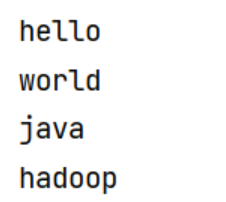
The same is true for copying pictures to files:
Code example:
import java.io.FileInputStream;
import java.io.FileOutputStream;
public class Cdemo5 {
public static void main(String[] args) throws Exception{
FileInputStream br = new FileInputStream("Dora A dream.jpg");
FileOutputStream bw = new FileOutputStream("D:\\IdeaProjects\\dlam.jpg");
int length=0;
byte[] chars = new byte[1024];
while((length=br.read(chars))!=-1){
bw.write(chars,0,length);
}
bw.close();
br.close();
}
}Output result:
A jpg file is generated under this project:
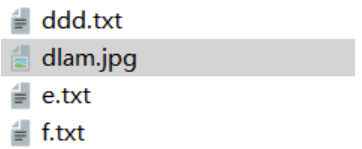
7. Special data writing method of character stream:
BufferedWriter:
void newLine() writes a line separator. The line separator string is determined by the system property line Separator definition, not necessarily a single line break ('\ n') character.
BufferedReader:
public String readLine() reads a line of text. A line is treated as a line feed ('\ n') and terminated by any one of the carriage return ('\ r') or subsequent line feeds.
Code example: no exceptions will be thrown here. Use the standard writing method in development:
import java.io.*;
public class Bdemo5 {
public static void main(String[] args) {
try {
write();
} catch (Exception e) {
e.printStackTrace();
}
try {
read();
} catch (Exception e) {
e.printStackTrace();
}
}
public static void write() throws Exception {
BufferedWriter bw = new BufferedWriter(new FileWriter("f.txt"));
for(int i=1;i<=10;i++){
bw.write("big data"+i);
bw.newLine();
}
bw.close();
}
public static void read() throws Exception {
BufferedReader br = new BufferedReader(new FileReader("f.txt"));
// public String readLine() reads one line of text at a time
//The string containing the contents of the line, excluding any line termination characters. It is null if it has reached the end of the stream
String line=null;
while((line=br.readLine())!=null){
System.out.println(line);
}
br.close();
}
}Output result: f.txt contains the data read as follows:
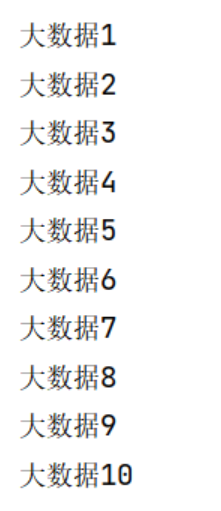
8. Stream of operation basic data type
DataOutputStream
DataInputStream
Code example: write data
import java.io.DataOutputStream;
import java.io.FileOutputStream;
public class Demo1 {
public static void main(String[] args) throws Exception{
DataOutputStream dos = new DataOutputStream(new FileOutputStream("d.txt"));
dos.writeByte(1);
dos.writeShort(5);
dos.writeInt(10);
dos.writeLong(1000L);
dos.writeChar('a');
dos.writeFloat(12.34F);
dos.writeDouble(34.56);
dos.writeBoolean(true);
dos.close();
}
}Output result: in the d.txt file, the content is garbled

But the content has been written to d.txt.
Read data of basic data type:
Note: here, it is necessary to ensure that the data type of written data is consistent with the data type order of read data.
import java.io.DataInputStream;
import java.io.FileInputStream;
public class Demo1a {
public static void main(String[] args) throws Exception {
DataInputStream dis = new DataInputStream(new FileInputStream("d.txt"));
System.out.println(dis.readByte());
System.out.println(dis.readShort());
System.out.println(dis.readInt());
System.out.println(dis.readLong());
System.out.println(dis.readChar());
System.out.println(dis.readFloat());
System.out.println(dis.readDouble());
System.out.println(dis.readBoolean());
dis.close();
}
}Output result:
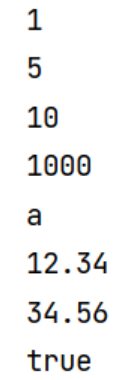
2, Serialization
Serialization: storing objects in a text file or database in the same way as a stream or transmitting them on the network
Object -- stream data: ObjectOutputStream
Deserialization: restore the stream object data in the text file or the stream data in the network to an object
Stream data --- object: ObjectInputStream
Code example:
Person class:
public class Person {
private String name;
private int age;
public Person() {
}
public Person(String name, int age) {
this.name = name;
this.age = age;
}
public String getName() {
return name;
}
public void setName(String name) {
this.name = name;
}
public int getAge() {
return age;
}
public void setAge(int age) {
this.age = age;
}
@Override
public String toString() {
return "Person{" +
"name='" + name + '\'' +
", age=" + age +
'}';
}
}Test class:
import java.io.FileInputStream;
import java.io.FileOutputStream;
import java.io.ObjectInputStream;
import java.io.ObjectOutputStream;
public class Demo1b {
public static void main(String[] args) {
// Write method: storing objects into files is actually to persist the objects
try {
write();
} catch (Exception e) {
e.printStackTrace();
}
// Read method: restore the stream object data in the text file or the stream data in the network to an object
//
try {
read();
} catch (Exception e) {
e.printStackTrace();
}
}
public static void write() throws Exception{
// Create object output stream object
ObjectOutputStream oos = new ObjectOutputStream(new FileOutputStream("g.txt"));
Person person = new Person("superman",20);
oos.writeObject(person);
oos.close();
}
public static void read() throws Exception{
// Create object input stream object
ObjectInputStream ois = new ObjectInputStream(new FileInputStream("g.txt"));
Object o = ois.readObject();
System.out.println(o);
ois.close();
}
}An error will appear here: NotSerializableException is not a serialized exception
Explanation: the serialization of classes is implemented by Java io. The class of the serializable interface is enabled. Classes that do not implement this interface will not serialize or deserialize any state. All subtypes of a serializable class are serializable.
The serialization interface has no methods or fields and is only used to identify Serializable semantics. Therefore, you need to implement the Serializable interface
You don't have to rewrite any methods.
Person class after interface implementation:
import java.io.Serializable;
public class Person implements Serializable {
private String name;
int age;
public Person() {
}
public Person(String name, int age) {
this.name = name;
this.age = age;
}
public String getName() {
return name;
}
public void setName(String name) {
this.name = name;
}
public int getAge() {
return age;
}
public void setAge(int age) {
this.age = age;
}
@Override
public String toString() {
return "Person{" +
"name='" + name + '\'' +
", age=" + age +
'}';
}
}Results after running again:

However, if the permission modifier of age in the Person class is removed and changed, and then the data reading method is run separately, an error will be reported: InvalidClassException
Explanation: Serializable here represents a tag, which is equivalent to a tag value. If the tag value given at the beginning is 100, the tag values of write data and read data are 100. After writing data and reading data, modify the Person class. At this time, a new tag value 200 will be generated for the changed Person class. When using this tag to read data, The Person tag is 200, but the tags for writing and reading data have not been modified and are still 100, so the tag cannot be found, so an error is reported.
terms of settlement:
There is a method that will not affect the tag value when modifying the class. Java provides an ID value: serialVersionUID
At the same time, if you don't want a value stored in the file, Java provides a keyword so that we can choose which members are not serialized in the serialization process: transient
Final code:
import java.io.Serializable;
public class Person implements Serializable {
private static final long serialVersionUID = -1408968761740608781L;
private String name;
private transient int age;
public Person() {
}
public Person(String name, int age) {
this.name = name;
this.age = age;
}
public String getName() {
return name;
}
public void setName(String name) {
this.name = name;
}
public int getAge() {
return age;
}
public void setAge(int age) {
this.age = age;
}
@Override
public String toString() {
return "Person{" +
"name='" + name + '\'' +
", age=" + age +
'}';
}
}Output result:

The age changes to the default value of 0